Driving Forces of Australia's Climate Change Approach
VerifiedAdded on 2021/04/21
|8
|3601
|42
Essay
AI Summary
This essay provides a comprehensive analysis of Australia's approach to international action on climate change. It begins by outlining global actions, including the United Nations Framework Convention on Climate Change (UNFCCC) and the Kyoto Protocol, which set the stage for international efforts to address climate change. The essay then delves into key theories of foreign policy, such as Realism, Liberalism, and Constructivism, to understand how these theories shape a nation's approach to global issues. The core of the essay focuses on Australia's specific initiatives, including its initial stance on the Kyoto Protocol, its subsequent policy changes, and the various schemes and trading systems it has implemented. The essay also discusses the impact of political changes, such as the election of the Rudd Government, on Australia's climate change policies. Overall, the essay highlights the complex interplay of international agreements, domestic politics, and economic considerations that have shaped Australia's approach to climate change.
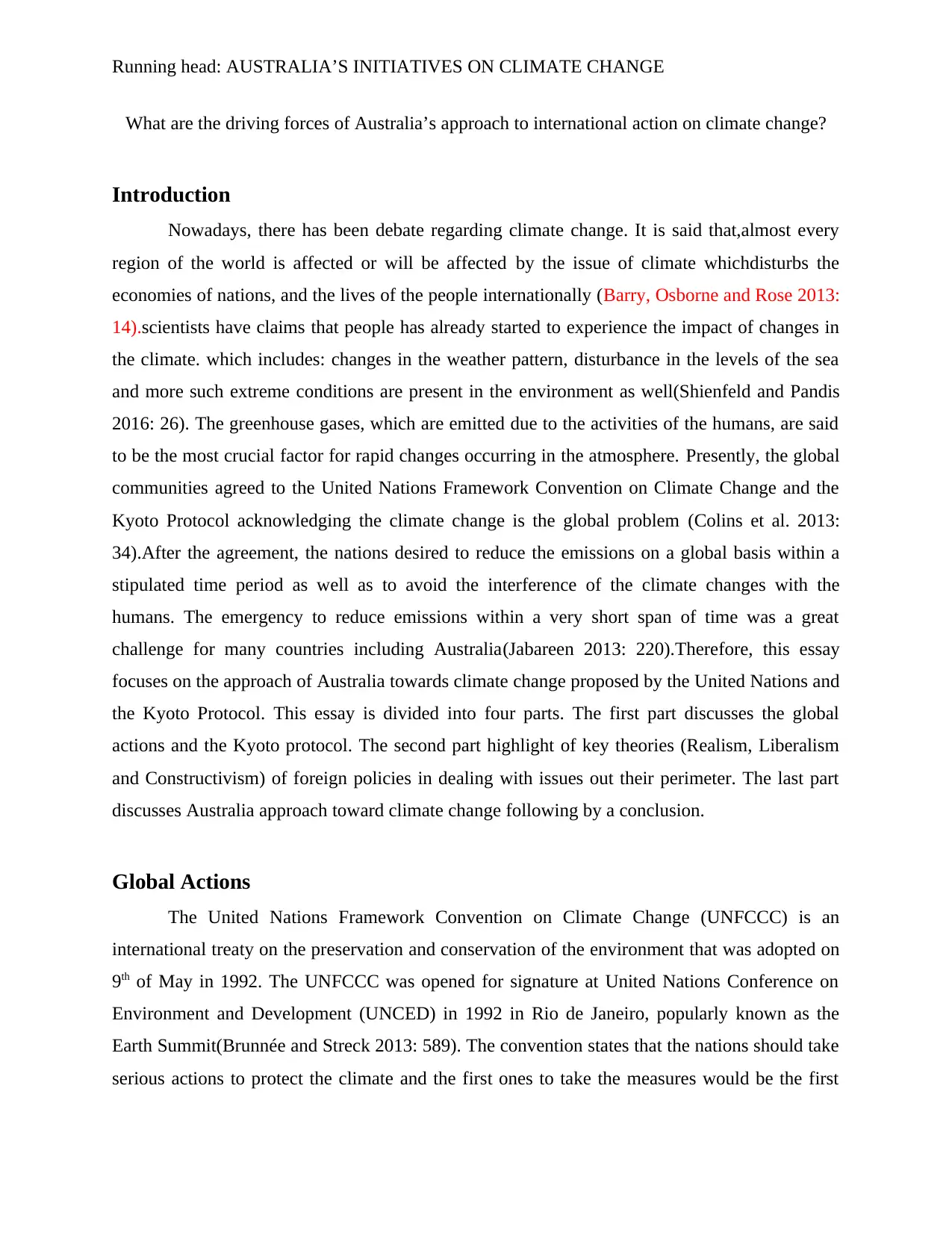
Running head: AUSTRALIA’S INITIATIVES ON CLIMATE CHANGE
What are the driving forces of Australia’s approach to international action on climate change?
Introduction
Nowadays, there has been debate regarding climate change. It is said that,almost every
region of the world is affected or will be affected by the issue of climate whichdisturbs the
economies of nations, and the lives of the people internationally (Barry, Osborne and Rose 2013:
14).scientists have claims that people has already started to experience the impact of changes in
the climate. which includes: changes in the weather pattern, disturbance in the levels of the sea
and more such extreme conditions are present in the environment as well(Shienfeld and Pandis
2016: 26). The greenhouse gases, which are emitted due to the activities of the humans, are said
to be the most crucial factor for rapid changes occurring in the atmosphere. Presently, the global
communities agreed to the United Nations Framework Convention on Climate Change and the
Kyoto Protocol acknowledging the climate change is the global problem (Colins et al. 2013:
34).After the agreement, the nations desired to reduce the emissions on a global basis within a
stipulated time period as well as to avoid the interference of the climate changes with the
humans. The emergency to reduce emissions within a very short span of time was a great
challenge for many countries including Australia(Jabareen 2013: 220).Therefore, this essay
focuses on the approach of Australia towards climate change proposed by the United Nations and
the Kyoto Protocol. This essay is divided into four parts. The first part discusses the global
actions and the Kyoto protocol. The second part highlight of key theories (Realism, Liberalism
and Constructivism) of foreign policies in dealing with issues out their perimeter. The last part
discusses Australia approach toward climate change following by a conclusion.
Global Actions
The United Nations Framework Convention on Climate Change (UNFCCC) is an
international treaty on the preservation and conservation of the environment that was adopted on
9th of May in 1992. The UNFCCC was opened for signature at United Nations Conference on
Environment and Development (UNCED) in 1992 in Rio de Janeiro, popularly known as the
Earth Summit(Brunnée and Streck 2013: 589). The convention states that the nations should take
serious actions to protect the climate and the first ones to take the measures would be the first
What are the driving forces of Australia’s approach to international action on climate change?
Introduction
Nowadays, there has been debate regarding climate change. It is said that,almost every
region of the world is affected or will be affected by the issue of climate whichdisturbs the
economies of nations, and the lives of the people internationally (Barry, Osborne and Rose 2013:
14).scientists have claims that people has already started to experience the impact of changes in
the climate. which includes: changes in the weather pattern, disturbance in the levels of the sea
and more such extreme conditions are present in the environment as well(Shienfeld and Pandis
2016: 26). The greenhouse gases, which are emitted due to the activities of the humans, are said
to be the most crucial factor for rapid changes occurring in the atmosphere. Presently, the global
communities agreed to the United Nations Framework Convention on Climate Change and the
Kyoto Protocol acknowledging the climate change is the global problem (Colins et al. 2013:
34).After the agreement, the nations desired to reduce the emissions on a global basis within a
stipulated time period as well as to avoid the interference of the climate changes with the
humans. The emergency to reduce emissions within a very short span of time was a great
challenge for many countries including Australia(Jabareen 2013: 220).Therefore, this essay
focuses on the approach of Australia towards climate change proposed by the United Nations and
the Kyoto Protocol. This essay is divided into four parts. The first part discusses the global
actions and the Kyoto protocol. The second part highlight of key theories (Realism, Liberalism
and Constructivism) of foreign policies in dealing with issues out their perimeter. The last part
discusses Australia approach toward climate change following by a conclusion.
Global Actions
The United Nations Framework Convention on Climate Change (UNFCCC) is an
international treaty on the preservation and conservation of the environment that was adopted on
9th of May in 1992. The UNFCCC was opened for signature at United Nations Conference on
Environment and Development (UNCED) in 1992 in Rio de Janeiro, popularly known as the
Earth Summit(Brunnée and Streck 2013: 589). The convention states that the nations should take
serious actions to protect the climate and the first ones to take the measures would be the first
Paraphrase This Document
Need a fresh take? Get an instant paraphrase of this document with our AI Paraphraser
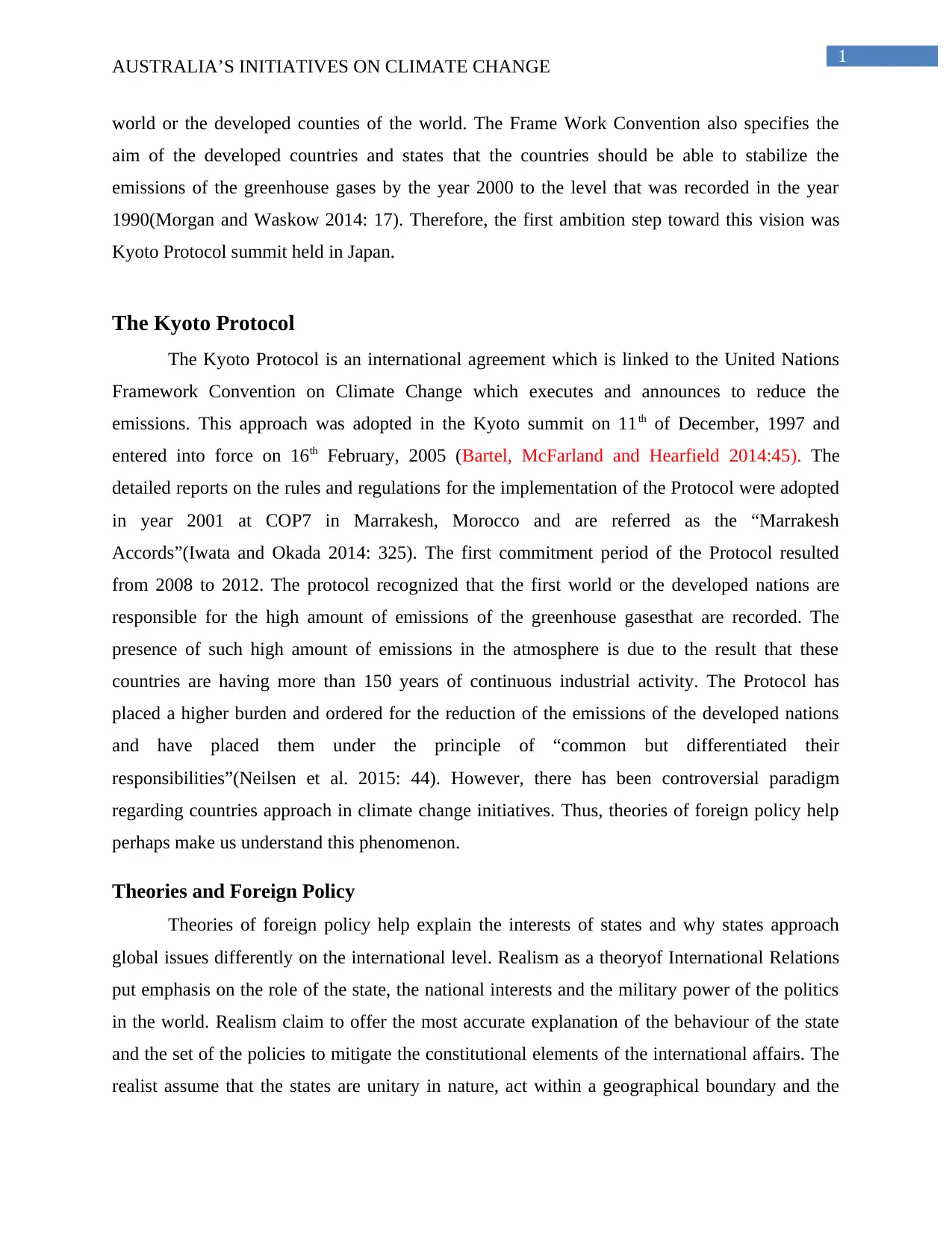
1
AUSTRALIA’S INITIATIVES ON CLIMATE CHANGE
world or the developed counties of the world. The Frame Work Convention also specifies the
aim of the developed countries and states that the countries should be able to stabilize the
emissions of the greenhouse gases by the year 2000 to the level that was recorded in the year
1990(Morgan and Waskow 2014: 17). Therefore, the first ambition step toward this vision was
Kyoto Protocol summit held in Japan.
The Kyoto Protocol
The Kyoto Protocol is an international agreement which is linked to the United Nations
Framework Convention on Climate Change which executes and announces to reduce the
emissions. This approach was adopted in the Kyoto summit on 11th of December, 1997 and
entered into force on 16th February, 2005 (Bartel, McFarland and Hearfield 2014:45). The
detailed reports on the rules and regulations for the implementation of the Protocol were adopted
in year 2001 at COP7 in Marrakesh, Morocco and are referred as the “Marrakesh
Accords”(Iwata and Okada 2014: 325). The first commitment period of the Protocol resulted
from 2008 to 2012. The protocol recognized that the first world or the developed nations are
responsible for the high amount of emissions of the greenhouse gasesthat are recorded. The
presence of such high amount of emissions in the atmosphere is due to the result that these
countries are having more than 150 years of continuous industrial activity. The Protocol has
placed a higher burden and ordered for the reduction of the emissions of the developed nations
and have placed them under the principle of “common but differentiated their
responsibilities”(Neilsen et al. 2015: 44). However, there has been controversial paradigm
regarding countries approach in climate change initiatives. Thus, theories of foreign policy help
perhaps make us understand this phenomenon.
Theories and Foreign Policy
Theories of foreign policy help explain the interests of states and why states approach
global issues differently on the international level. Realism as a theoryof International Relations
put emphasis on the role of the state, the national interests and the military power of the politics
in the world. Realism claim to offer the most accurate explanation of the behaviour of the state
and the set of the policies to mitigate the constitutional elements of the international affairs. The
realist assume that the states are unitary in nature, act within a geographical boundary and the
AUSTRALIA’S INITIATIVES ON CLIMATE CHANGE
world or the developed counties of the world. The Frame Work Convention also specifies the
aim of the developed countries and states that the countries should be able to stabilize the
emissions of the greenhouse gases by the year 2000 to the level that was recorded in the year
1990(Morgan and Waskow 2014: 17). Therefore, the first ambition step toward this vision was
Kyoto Protocol summit held in Japan.
The Kyoto Protocol
The Kyoto Protocol is an international agreement which is linked to the United Nations
Framework Convention on Climate Change which executes and announces to reduce the
emissions. This approach was adopted in the Kyoto summit on 11th of December, 1997 and
entered into force on 16th February, 2005 (Bartel, McFarland and Hearfield 2014:45). The
detailed reports on the rules and regulations for the implementation of the Protocol were adopted
in year 2001 at COP7 in Marrakesh, Morocco and are referred as the “Marrakesh
Accords”(Iwata and Okada 2014: 325). The first commitment period of the Protocol resulted
from 2008 to 2012. The protocol recognized that the first world or the developed nations are
responsible for the high amount of emissions of the greenhouse gasesthat are recorded. The
presence of such high amount of emissions in the atmosphere is due to the result that these
countries are having more than 150 years of continuous industrial activity. The Protocol has
placed a higher burden and ordered for the reduction of the emissions of the developed nations
and have placed them under the principle of “common but differentiated their
responsibilities”(Neilsen et al. 2015: 44). However, there has been controversial paradigm
regarding countries approach in climate change initiatives. Thus, theories of foreign policy help
perhaps make us understand this phenomenon.
Theories and Foreign Policy
Theories of foreign policy help explain the interests of states and why states approach
global issues differently on the international level. Realism as a theoryof International Relations
put emphasis on the role of the state, the national interests and the military power of the politics
in the world. Realism claim to offer the most accurate explanation of the behaviour of the state
and the set of the policies to mitigate the constitutional elements of the international affairs. The
realist assume that the states are unitary in nature, act within a geographical boundary and the
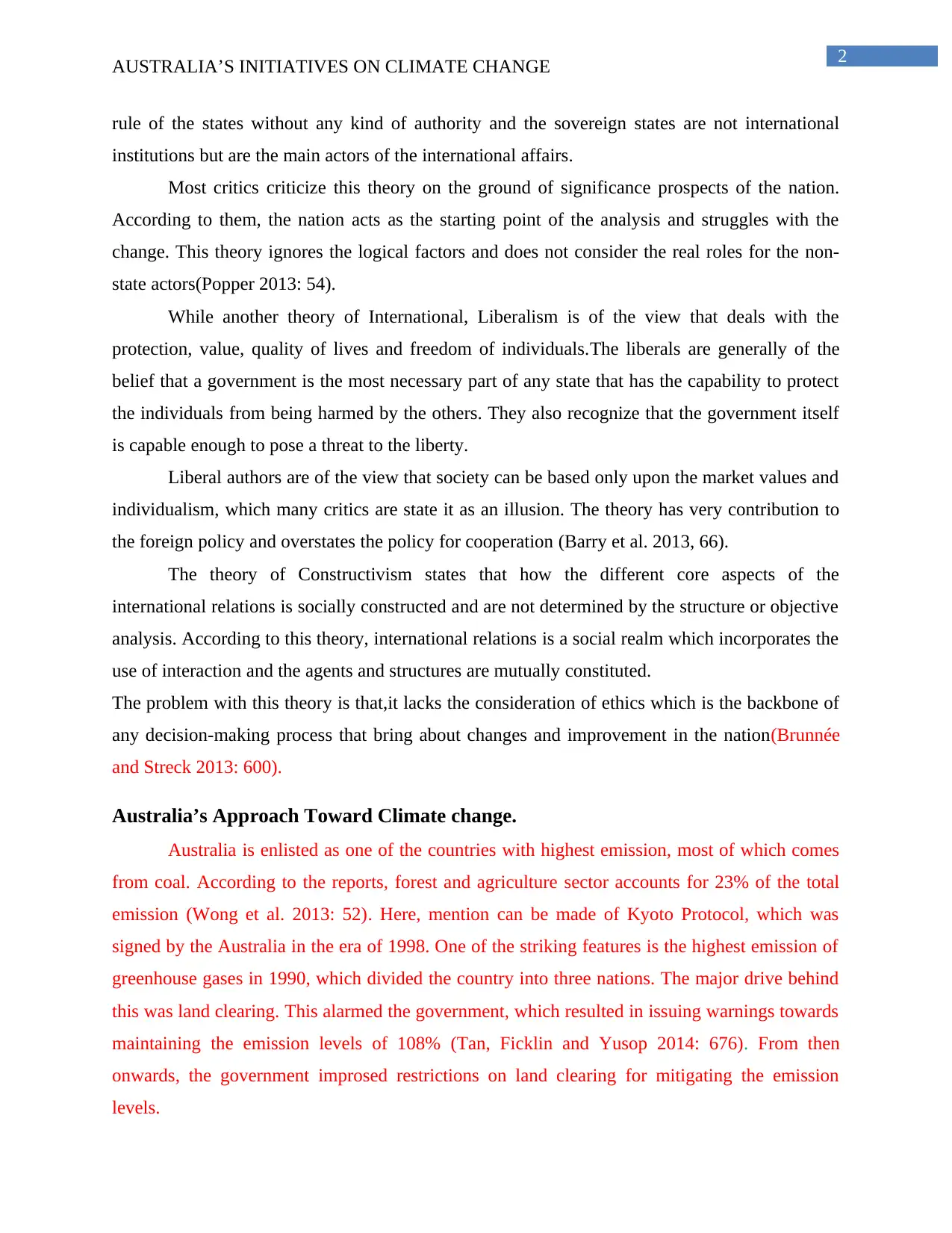
2
AUSTRALIA’S INITIATIVES ON CLIMATE CHANGE
rule of the states without any kind of authority and the sovereign states are not international
institutions but are the main actors of the international affairs.
Most critics criticize this theory on the ground of significance prospects of the nation.
According to them, the nation acts as the starting point of the analysis and struggles with the
change. This theory ignores the logical factors and does not consider the real roles for the non-
state actors(Popper 2013: 54).
While another theory of International, Liberalism is of the view that deals with the
protection, value, quality of lives and freedom of individuals.The liberals are generally of the
belief that a government is the most necessary part of any state that has the capability to protect
the individuals from being harmed by the others. They also recognize that the government itself
is capable enough to pose a threat to the liberty.
Liberal authors are of the view that society can be based only upon the market values and
individualism, which many critics are state it as an illusion. The theory has very contribution to
the foreign policy and overstates the policy for cooperation (Barry et al. 2013, 66).
The theory of Constructivism states that how the different core aspects of the
international relations is socially constructed and are not determined by the structure or objective
analysis. According to this theory, international relations is a social realm which incorporates the
use of interaction and the agents and structures are mutually constituted.
The problem with this theory is that,it lacks the consideration of ethics which is the backbone of
any decision-making process that bring about changes and improvement in the nation(Brunnée
and Streck 2013: 600).
Australia’s Approach Toward Climate change.
Australia is enlisted as one of the countries with highest emission, most of which comes
from coal. According to the reports, forest and agriculture sector accounts for 23% of the total
emission (Wong et al. 2013: 52). Here, mention can be made of Kyoto Protocol, which was
signed by the Australia in the era of 1998. One of the striking features is the highest emission of
greenhouse gases in 1990, which divided the country into three nations. The major drive behind
this was land clearing. This alarmed the government, which resulted in issuing warnings towards
maintaining the emission levels of 108% (Tan, Ficklin and Yusop 2014: 676). From then
onwards, the government improsed restrictions on land clearing for mitigating the emission
levels.
AUSTRALIA’S INITIATIVES ON CLIMATE CHANGE
rule of the states without any kind of authority and the sovereign states are not international
institutions but are the main actors of the international affairs.
Most critics criticize this theory on the ground of significance prospects of the nation.
According to them, the nation acts as the starting point of the analysis and struggles with the
change. This theory ignores the logical factors and does not consider the real roles for the non-
state actors(Popper 2013: 54).
While another theory of International, Liberalism is of the view that deals with the
protection, value, quality of lives and freedom of individuals.The liberals are generally of the
belief that a government is the most necessary part of any state that has the capability to protect
the individuals from being harmed by the others. They also recognize that the government itself
is capable enough to pose a threat to the liberty.
Liberal authors are of the view that society can be based only upon the market values and
individualism, which many critics are state it as an illusion. The theory has very contribution to
the foreign policy and overstates the policy for cooperation (Barry et al. 2013, 66).
The theory of Constructivism states that how the different core aspects of the
international relations is socially constructed and are not determined by the structure or objective
analysis. According to this theory, international relations is a social realm which incorporates the
use of interaction and the agents and structures are mutually constituted.
The problem with this theory is that,it lacks the consideration of ethics which is the backbone of
any decision-making process that bring about changes and improvement in the nation(Brunnée
and Streck 2013: 600).
Australia’s Approach Toward Climate change.
Australia is enlisted as one of the countries with highest emission, most of which comes
from coal. According to the reports, forest and agriculture sector accounts for 23% of the total
emission (Wong et al. 2013: 52). Here, mention can be made of Kyoto Protocol, which was
signed by the Australia in the era of 1998. One of the striking features is the highest emission of
greenhouse gases in 1990, which divided the country into three nations. The major drive behind
this was land clearing. This alarmed the government, which resulted in issuing warnings towards
maintaining the emission levels of 108% (Tan, Ficklin and Yusop 2014: 676). From then
onwards, the government improsed restrictions on land clearing for mitigating the emission
levels.
⊘ This is a preview!⊘
Do you want full access?
Subscribe today to unlock all pages.

Trusted by 1+ million students worldwide
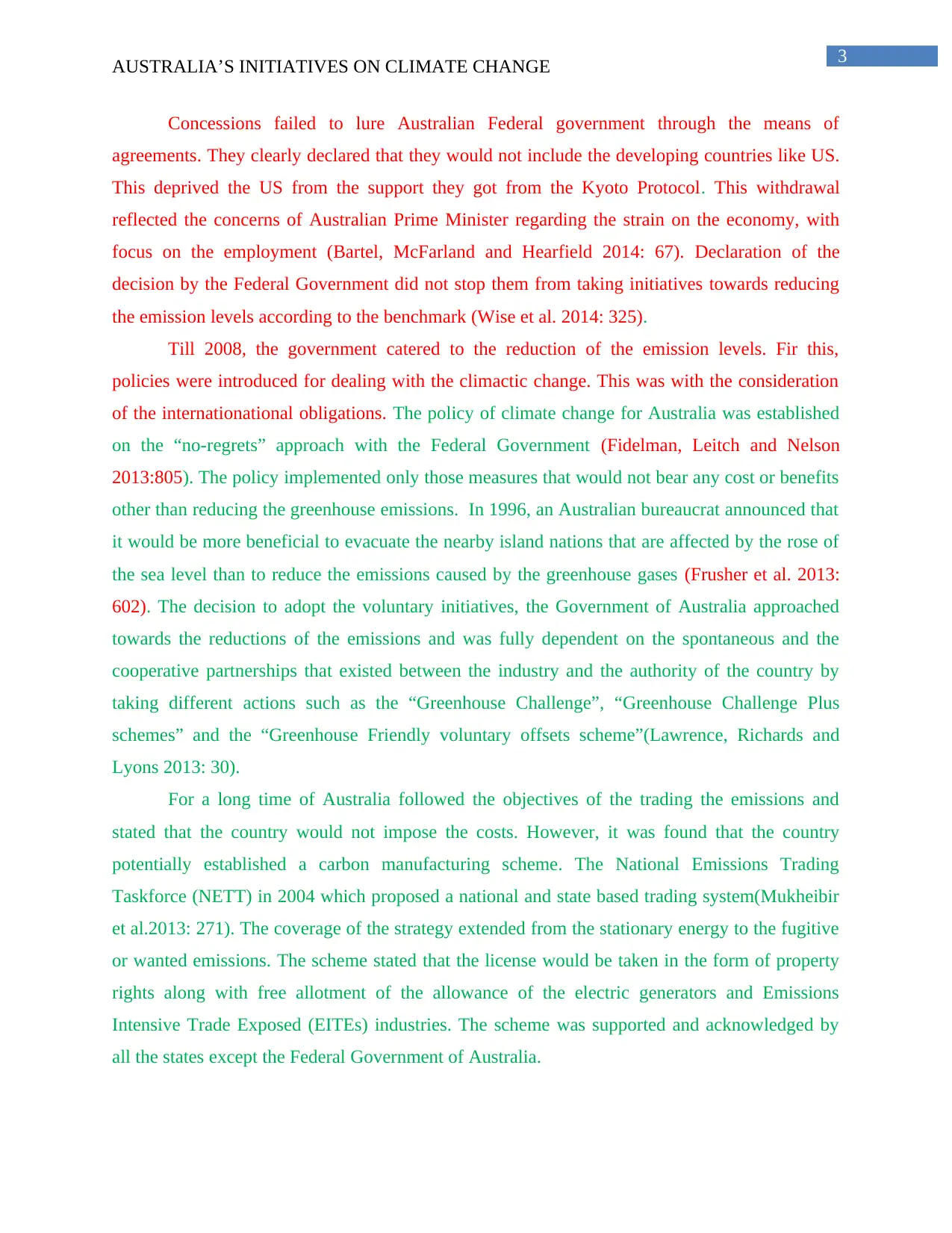
3
AUSTRALIA’S INITIATIVES ON CLIMATE CHANGE
Concessions failed to lure Australian Federal government through the means of
agreements. They clearly declared that they would not include the developing countries like US.
This deprived the US from the support they got from the Kyoto Protocol. This withdrawal
reflected the concerns of Australian Prime Minister regarding the strain on the economy, with
focus on the employment (Bartel, McFarland and Hearfield 2014: 67). Declaration of the
decision by the Federal Government did not stop them from taking initiatives towards reducing
the emission levels according to the benchmark (Wise et al. 2014: 325).
Till 2008, the government catered to the reduction of the emission levels. Fir this,
policies were introduced for dealing with the climactic change. This was with the consideration
of the internationational obligations. The policy of climate change for Australia was established
on the “no-regrets” approach with the Federal Government (Fidelman, Leitch and Nelson
2013:805). The policy implemented only those measures that would not bear any cost or benefits
other than reducing the greenhouse emissions. In 1996, an Australian bureaucrat announced that
it would be more beneficial to evacuate the nearby island nations that are affected by the rose of
the sea level than to reduce the emissions caused by the greenhouse gases (Frusher et al. 2013:
602). The decision to adopt the voluntary initiatives, the Government of Australia approached
towards the reductions of the emissions and was fully dependent on the spontaneous and the
cooperative partnerships that existed between the industry and the authority of the country by
taking different actions such as the “Greenhouse Challenge”, “Greenhouse Challenge Plus
schemes” and the “Greenhouse Friendly voluntary offsets scheme”(Lawrence, Richards and
Lyons 2013: 30).
For a long time of Australia followed the objectives of the trading the emissions and
stated that the country would not impose the costs. However, it was found that the country
potentially established a carbon manufacturing scheme. The National Emissions Trading
Taskforce (NETT) in 2004 which proposed a national and state based trading system(Mukheibir
et al.2013: 271). The coverage of the strategy extended from the stationary energy to the fugitive
or wanted emissions. The scheme stated that the license would be taken in the form of property
rights along with free allotment of the allowance of the electric generators and Emissions
Intensive Trade Exposed (EITEs) industries. The scheme was supported and acknowledged by
all the states except the Federal Government of Australia.
AUSTRALIA’S INITIATIVES ON CLIMATE CHANGE
Concessions failed to lure Australian Federal government through the means of
agreements. They clearly declared that they would not include the developing countries like US.
This deprived the US from the support they got from the Kyoto Protocol. This withdrawal
reflected the concerns of Australian Prime Minister regarding the strain on the economy, with
focus on the employment (Bartel, McFarland and Hearfield 2014: 67). Declaration of the
decision by the Federal Government did not stop them from taking initiatives towards reducing
the emission levels according to the benchmark (Wise et al. 2014: 325).
Till 2008, the government catered to the reduction of the emission levels. Fir this,
policies were introduced for dealing with the climactic change. This was with the consideration
of the internationational obligations. The policy of climate change for Australia was established
on the “no-regrets” approach with the Federal Government (Fidelman, Leitch and Nelson
2013:805). The policy implemented only those measures that would not bear any cost or benefits
other than reducing the greenhouse emissions. In 1996, an Australian bureaucrat announced that
it would be more beneficial to evacuate the nearby island nations that are affected by the rose of
the sea level than to reduce the emissions caused by the greenhouse gases (Frusher et al. 2013:
602). The decision to adopt the voluntary initiatives, the Government of Australia approached
towards the reductions of the emissions and was fully dependent on the spontaneous and the
cooperative partnerships that existed between the industry and the authority of the country by
taking different actions such as the “Greenhouse Challenge”, “Greenhouse Challenge Plus
schemes” and the “Greenhouse Friendly voluntary offsets scheme”(Lawrence, Richards and
Lyons 2013: 30).
For a long time of Australia followed the objectives of the trading the emissions and
stated that the country would not impose the costs. However, it was found that the country
potentially established a carbon manufacturing scheme. The National Emissions Trading
Taskforce (NETT) in 2004 which proposed a national and state based trading system(Mukheibir
et al.2013: 271). The coverage of the strategy extended from the stationary energy to the fugitive
or wanted emissions. The scheme stated that the license would be taken in the form of property
rights along with free allotment of the allowance of the electric generators and Emissions
Intensive Trade Exposed (EITEs) industries. The scheme was supported and acknowledged by
all the states except the Federal Government of Australia.
Paraphrase This Document
Need a fresh take? Get an instant paraphrase of this document with our AI Paraphraser
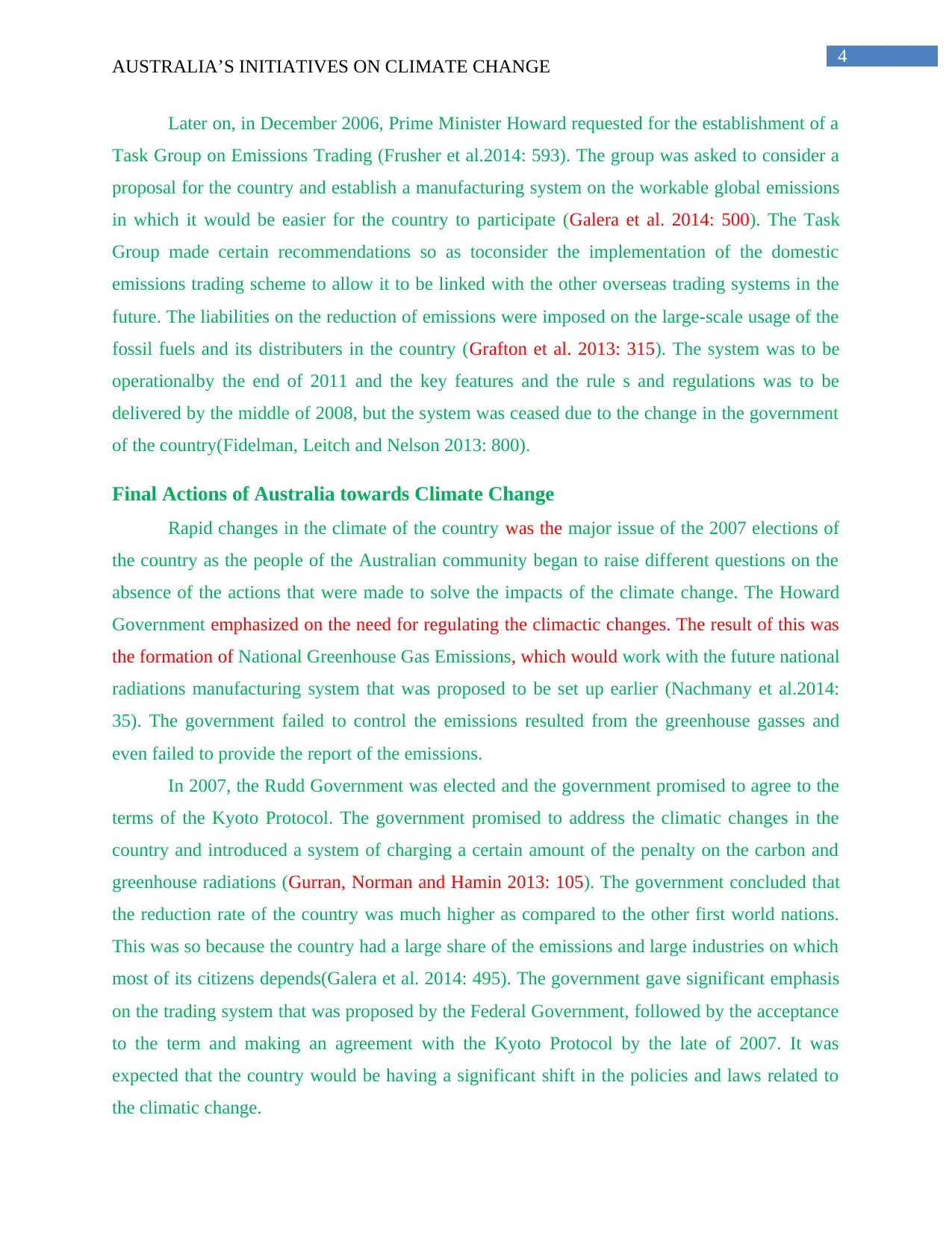
4
AUSTRALIA’S INITIATIVES ON CLIMATE CHANGE
Later on, in December 2006, Prime Minister Howard requested for the establishment of a
Task Group on Emissions Trading (Frusher et al.2014: 593). The group was asked to consider a
proposal for the country and establish a manufacturing system on the workable global emissions
in which it would be easier for the country to participate (Galera et al. 2014: 500). The Task
Group made certain recommendations so as toconsider the implementation of the domestic
emissions trading scheme to allow it to be linked with the other overseas trading systems in the
future. The liabilities on the reduction of emissions were imposed on the large-scale usage of the
fossil fuels and its distributers in the country (Grafton et al. 2013: 315). The system was to be
operationalby the end of 2011 and the key features and the rule s and regulations was to be
delivered by the middle of 2008, but the system was ceased due to the change in the government
of the country(Fidelman, Leitch and Nelson 2013: 800).
Final Actions of Australia towards Climate Change
Rapid changes in the climate of the country was the major issue of the 2007 elections of
the country as the people of the Australian community began to raise different questions on the
absence of the actions that were made to solve the impacts of the climate change. The Howard
Government emphasized on the need for regulating the climactic changes. The result of this was
the formation of National Greenhouse Gas Emissions, which would work with the future national
radiations manufacturing system that was proposed to be set up earlier (Nachmany et al.2014:
35). The government failed to control the emissions resulted from the greenhouse gasses and
even failed to provide the report of the emissions.
In 2007, the Rudd Government was elected and the government promised to agree to the
terms of the Kyoto Protocol. The government promised to address the climatic changes in the
country and introduced a system of charging a certain amount of the penalty on the carbon and
greenhouse radiations (Gurran, Norman and Hamin 2013: 105). The government concluded that
the reduction rate of the country was much higher as compared to the other first world nations.
This was so because the country had a large share of the emissions and large industries on which
most of its citizens depends(Galera et al. 2014: 495). The government gave significant emphasis
on the trading system that was proposed by the Federal Government, followed by the acceptance
to the term and making an agreement with the Kyoto Protocol by the late of 2007. It was
expected that the country would be having a significant shift in the policies and laws related to
the climatic change.
AUSTRALIA’S INITIATIVES ON CLIMATE CHANGE
Later on, in December 2006, Prime Minister Howard requested for the establishment of a
Task Group on Emissions Trading (Frusher et al.2014: 593). The group was asked to consider a
proposal for the country and establish a manufacturing system on the workable global emissions
in which it would be easier for the country to participate (Galera et al. 2014: 500). The Task
Group made certain recommendations so as toconsider the implementation of the domestic
emissions trading scheme to allow it to be linked with the other overseas trading systems in the
future. The liabilities on the reduction of emissions were imposed on the large-scale usage of the
fossil fuels and its distributers in the country (Grafton et al. 2013: 315). The system was to be
operationalby the end of 2011 and the key features and the rule s and regulations was to be
delivered by the middle of 2008, but the system was ceased due to the change in the government
of the country(Fidelman, Leitch and Nelson 2013: 800).
Final Actions of Australia towards Climate Change
Rapid changes in the climate of the country was the major issue of the 2007 elections of
the country as the people of the Australian community began to raise different questions on the
absence of the actions that were made to solve the impacts of the climate change. The Howard
Government emphasized on the need for regulating the climactic changes. The result of this was
the formation of National Greenhouse Gas Emissions, which would work with the future national
radiations manufacturing system that was proposed to be set up earlier (Nachmany et al.2014:
35). The government failed to control the emissions resulted from the greenhouse gasses and
even failed to provide the report of the emissions.
In 2007, the Rudd Government was elected and the government promised to agree to the
terms of the Kyoto Protocol. The government promised to address the climatic changes in the
country and introduced a system of charging a certain amount of the penalty on the carbon and
greenhouse radiations (Gurran, Norman and Hamin 2013: 105). The government concluded that
the reduction rate of the country was much higher as compared to the other first world nations.
This was so because the country had a large share of the emissions and large industries on which
most of its citizens depends(Galera et al. 2014: 495). The government gave significant emphasis
on the trading system that was proposed by the Federal Government, followed by the acceptance
to the term and making an agreement with the Kyoto Protocol by the late of 2007. It was
expected that the country would be having a significant shift in the policies and laws related to
the climatic change.
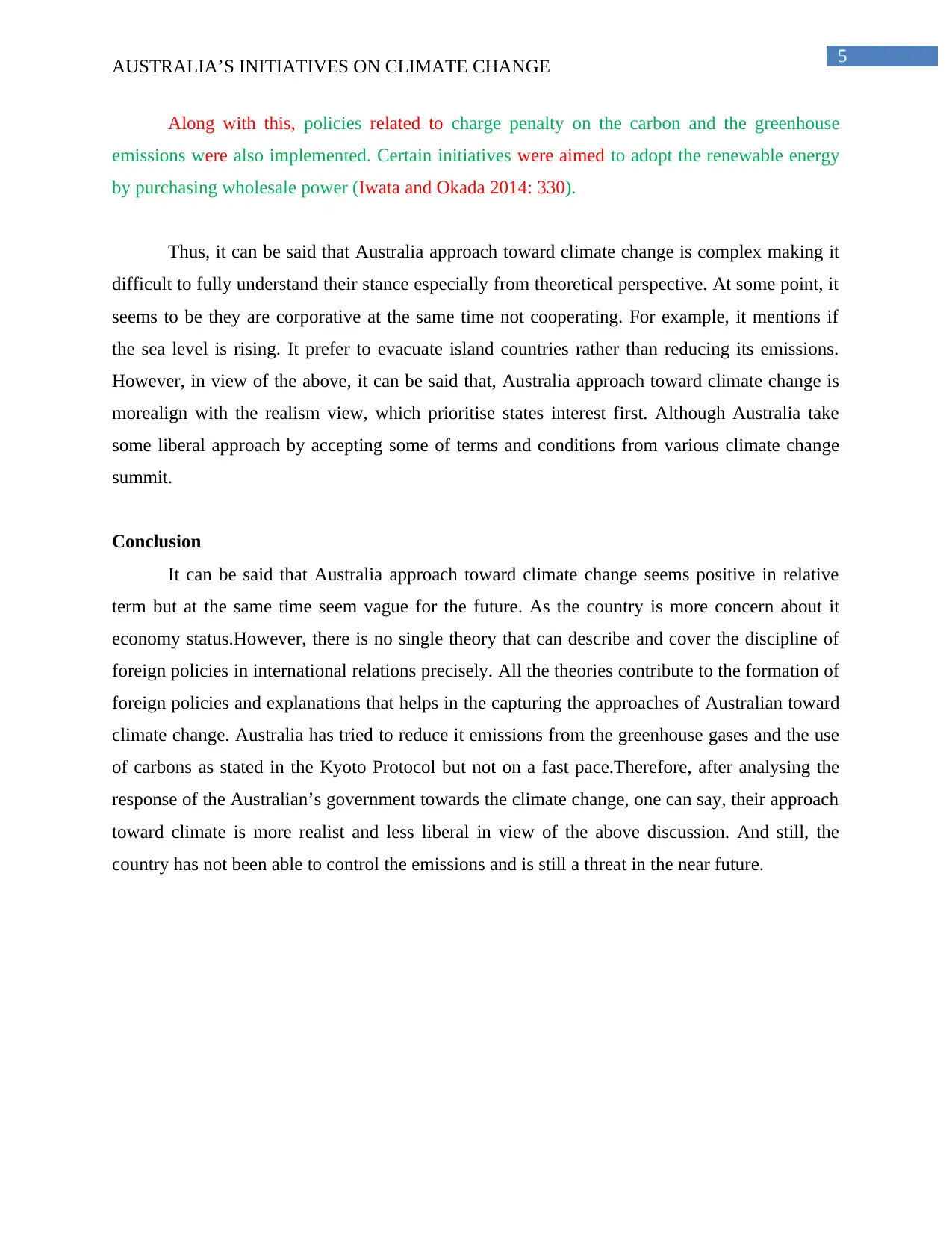
5
AUSTRALIA’S INITIATIVES ON CLIMATE CHANGE
Along with this, policies related to charge penalty on the carbon and the greenhouse
emissions were also implemented. Certain initiatives were aimed to adopt the renewable energy
by purchasing wholesale power (Iwata and Okada 2014: 330).
Thus, it can be said that Australia approach toward climate change is complex making it
difficult to fully understand their stance especially from theoretical perspective. At some point, it
seems to be they are corporative at the same time not cooperating. For example, it mentions if
the sea level is rising. It prefer to evacuate island countries rather than reducing its emissions.
However, in view of the above, it can be said that, Australia approach toward climate change is
morealign with the realism view, which prioritise states interest first. Although Australia take
some liberal approach by accepting some of terms and conditions from various climate change
summit.
Conclusion
It can be said that Australia approach toward climate change seems positive in relative
term but at the same time seem vague for the future. As the country is more concern about it
economy status.However, there is no single theory that can describe and cover the discipline of
foreign policies in international relations precisely. All the theories contribute to the formation of
foreign policies and explanations that helps in the capturing the approaches of Australian toward
climate change. Australia has tried to reduce it emissions from the greenhouse gases and the use
of carbons as stated in the Kyoto Protocol but not on a fast pace.Therefore, after analysing the
response of the Australian’s government towards the climate change, one can say, their approach
toward climate is more realist and less liberal in view of the above discussion. And still, the
country has not been able to control the emissions and is still a threat in the near future.
AUSTRALIA’S INITIATIVES ON CLIMATE CHANGE
Along with this, policies related to charge penalty on the carbon and the greenhouse
emissions were also implemented. Certain initiatives were aimed to adopt the renewable energy
by purchasing wholesale power (Iwata and Okada 2014: 330).
Thus, it can be said that Australia approach toward climate change is complex making it
difficult to fully understand their stance especially from theoretical perspective. At some point, it
seems to be they are corporative at the same time not cooperating. For example, it mentions if
the sea level is rising. It prefer to evacuate island countries rather than reducing its emissions.
However, in view of the above, it can be said that, Australia approach toward climate change is
morealign with the realism view, which prioritise states interest first. Although Australia take
some liberal approach by accepting some of terms and conditions from various climate change
summit.
Conclusion
It can be said that Australia approach toward climate change seems positive in relative
term but at the same time seem vague for the future. As the country is more concern about it
economy status.However, there is no single theory that can describe and cover the discipline of
foreign policies in international relations precisely. All the theories contribute to the formation of
foreign policies and explanations that helps in the capturing the approaches of Australian toward
climate change. Australia has tried to reduce it emissions from the greenhouse gases and the use
of carbons as stated in the Kyoto Protocol but not on a fast pace.Therefore, after analysing the
response of the Australian’s government towards the climate change, one can say, their approach
toward climate is more realist and less liberal in view of the above discussion. And still, the
country has not been able to control the emissions and is still a threat in the near future.
⊘ This is a preview!⊘
Do you want full access?
Subscribe today to unlock all pages.

Trusted by 1+ million students worldwide
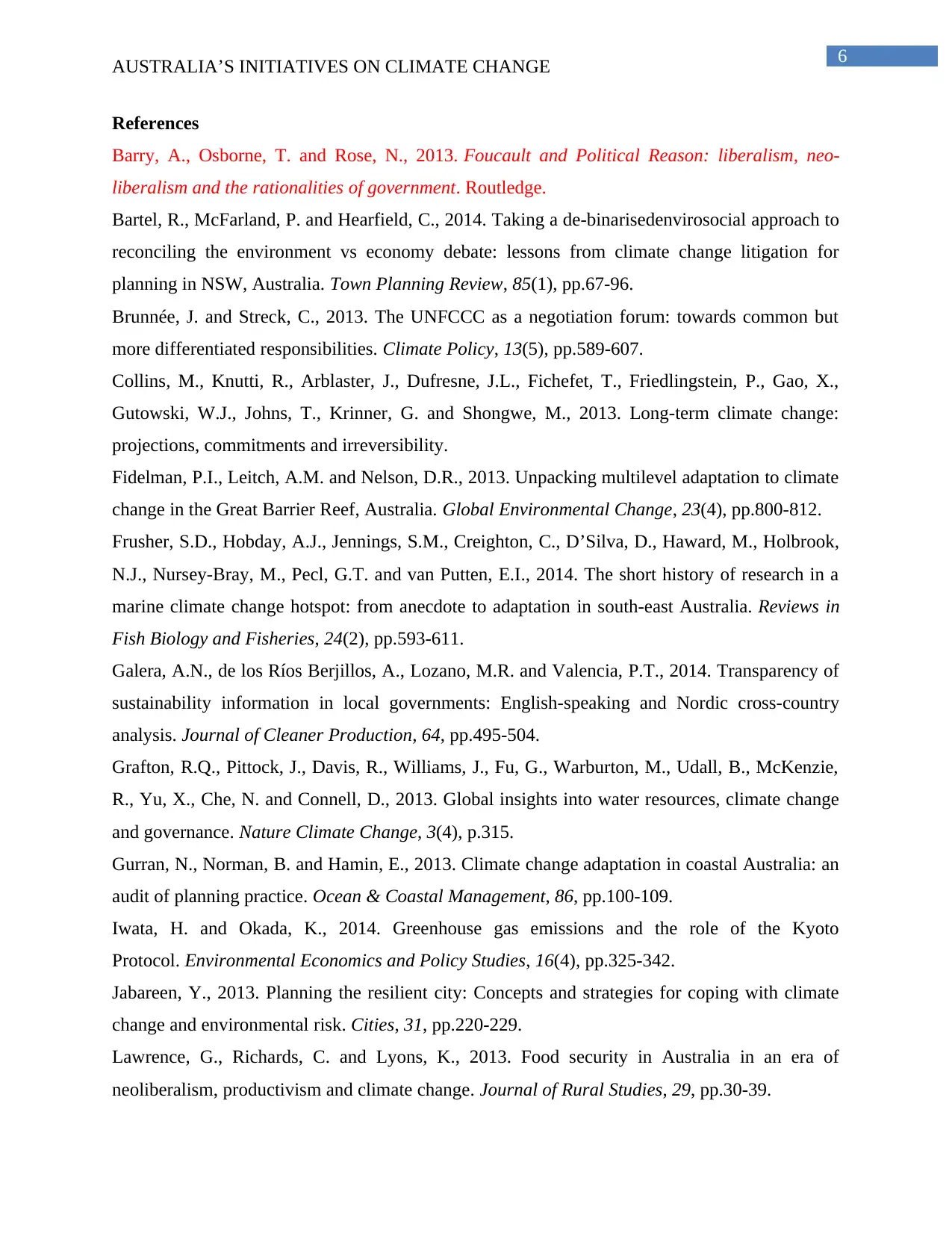
6
AUSTRALIA’S INITIATIVES ON CLIMATE CHANGE
References
Barry, A., Osborne, T. and Rose, N., 2013. Foucault and Political Reason: liberalism, neo-
liberalism and the rationalities of government. Routledge.
Bartel, R., McFarland, P. and Hearfield, C., 2014. Taking a de-binarisedenvirosocial approach to
reconciling the environment vs economy debate: lessons from climate change litigation for
planning in NSW, Australia. Town Planning Review, 85(1), pp.67-96.
Brunnée, J. and Streck, C., 2013. The UNFCCC as a negotiation forum: towards common but
more differentiated responsibilities. Climate Policy, 13(5), pp.589-607.
Collins, M., Knutti, R., Arblaster, J., Dufresne, J.L., Fichefet, T., Friedlingstein, P., Gao, X.,
Gutowski, W.J., Johns, T., Krinner, G. and Shongwe, M., 2013. Long-term climate change:
projections, commitments and irreversibility.
Fidelman, P.I., Leitch, A.M. and Nelson, D.R., 2013. Unpacking multilevel adaptation to climate
change in the Great Barrier Reef, Australia. Global Environmental Change, 23(4), pp.800-812.
Frusher, S.D., Hobday, A.J., Jennings, S.M., Creighton, C., D’Silva, D., Haward, M., Holbrook,
N.J., Nursey-Bray, M., Pecl, G.T. and van Putten, E.I., 2014. The short history of research in a
marine climate change hotspot: from anecdote to adaptation in south-east Australia. Reviews in
Fish Biology and Fisheries, 24(2), pp.593-611.
Galera, A.N., de los Ríos Berjillos, A., Lozano, M.R. and Valencia, P.T., 2014. Transparency of
sustainability information in local governments: English-speaking and Nordic cross-country
analysis. Journal of Cleaner Production, 64, pp.495-504.
Grafton, R.Q., Pittock, J., Davis, R., Williams, J., Fu, G., Warburton, M., Udall, B., McKenzie,
R., Yu, X., Che, N. and Connell, D., 2013. Global insights into water resources, climate change
and governance. Nature Climate Change, 3(4), p.315.
Gurran, N., Norman, B. and Hamin, E., 2013. Climate change adaptation in coastal Australia: an
audit of planning practice. Ocean & Coastal Management, 86, pp.100-109.
Iwata, H. and Okada, K., 2014. Greenhouse gas emissions and the role of the Kyoto
Protocol. Environmental Economics and Policy Studies, 16(4), pp.325-342.
Jabareen, Y., 2013. Planning the resilient city: Concepts and strategies for coping with climate
change and environmental risk. Cities, 31, pp.220-229.
Lawrence, G., Richards, C. and Lyons, K., 2013. Food security in Australia in an era of
neoliberalism, productivism and climate change. Journal of Rural Studies, 29, pp.30-39.
AUSTRALIA’S INITIATIVES ON CLIMATE CHANGE
References
Barry, A., Osborne, T. and Rose, N., 2013. Foucault and Political Reason: liberalism, neo-
liberalism and the rationalities of government. Routledge.
Bartel, R., McFarland, P. and Hearfield, C., 2014. Taking a de-binarisedenvirosocial approach to
reconciling the environment vs economy debate: lessons from climate change litigation for
planning in NSW, Australia. Town Planning Review, 85(1), pp.67-96.
Brunnée, J. and Streck, C., 2013. The UNFCCC as a negotiation forum: towards common but
more differentiated responsibilities. Climate Policy, 13(5), pp.589-607.
Collins, M., Knutti, R., Arblaster, J., Dufresne, J.L., Fichefet, T., Friedlingstein, P., Gao, X.,
Gutowski, W.J., Johns, T., Krinner, G. and Shongwe, M., 2013. Long-term climate change:
projections, commitments and irreversibility.
Fidelman, P.I., Leitch, A.M. and Nelson, D.R., 2013. Unpacking multilevel adaptation to climate
change in the Great Barrier Reef, Australia. Global Environmental Change, 23(4), pp.800-812.
Frusher, S.D., Hobday, A.J., Jennings, S.M., Creighton, C., D’Silva, D., Haward, M., Holbrook,
N.J., Nursey-Bray, M., Pecl, G.T. and van Putten, E.I., 2014. The short history of research in a
marine climate change hotspot: from anecdote to adaptation in south-east Australia. Reviews in
Fish Biology and Fisheries, 24(2), pp.593-611.
Galera, A.N., de los Ríos Berjillos, A., Lozano, M.R. and Valencia, P.T., 2014. Transparency of
sustainability information in local governments: English-speaking and Nordic cross-country
analysis. Journal of Cleaner Production, 64, pp.495-504.
Grafton, R.Q., Pittock, J., Davis, R., Williams, J., Fu, G., Warburton, M., Udall, B., McKenzie,
R., Yu, X., Che, N. and Connell, D., 2013. Global insights into water resources, climate change
and governance. Nature Climate Change, 3(4), p.315.
Gurran, N., Norman, B. and Hamin, E., 2013. Climate change adaptation in coastal Australia: an
audit of planning practice. Ocean & Coastal Management, 86, pp.100-109.
Iwata, H. and Okada, K., 2014. Greenhouse gas emissions and the role of the Kyoto
Protocol. Environmental Economics and Policy Studies, 16(4), pp.325-342.
Jabareen, Y., 2013. Planning the resilient city: Concepts and strategies for coping with climate
change and environmental risk. Cities, 31, pp.220-229.
Lawrence, G., Richards, C. and Lyons, K., 2013. Food security in Australia in an era of
neoliberalism, productivism and climate change. Journal of Rural Studies, 29, pp.30-39.
Paraphrase This Document
Need a fresh take? Get an instant paraphrase of this document with our AI Paraphraser
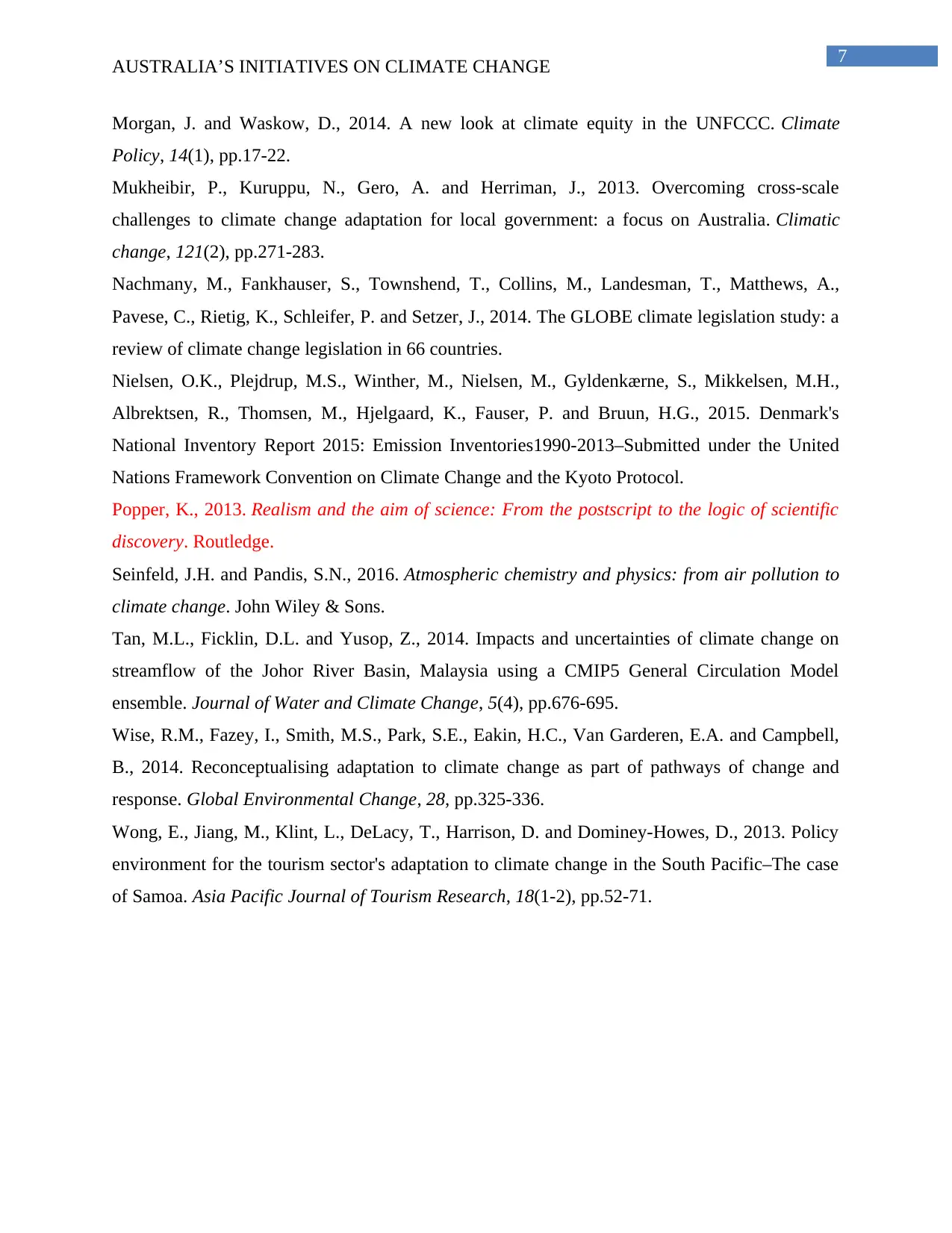
7
AUSTRALIA’S INITIATIVES ON CLIMATE CHANGE
Morgan, J. and Waskow, D., 2014. A new look at climate equity in the UNFCCC. Climate
Policy, 14(1), pp.17-22.
Mukheibir, P., Kuruppu, N., Gero, A. and Herriman, J., 2013. Overcoming cross-scale
challenges to climate change adaptation for local government: a focus on Australia. Climatic
change, 121(2), pp.271-283.
Nachmany, M., Fankhauser, S., Townshend, T., Collins, M., Landesman, T., Matthews, A.,
Pavese, C., Rietig, K., Schleifer, P. and Setzer, J., 2014. The GLOBE climate legislation study: a
review of climate change legislation in 66 countries.
Nielsen, O.K., Plejdrup, M.S., Winther, M., Nielsen, M., Gyldenkærne, S., Mikkelsen, M.H.,
Albrektsen, R., Thomsen, M., Hjelgaard, K., Fauser, P. and Bruun, H.G., 2015. Denmark's
National Inventory Report 2015: Emission Inventories1990-2013–Submitted under the United
Nations Framework Convention on Climate Change and the Kyoto Protocol.
Popper, K., 2013. Realism and the aim of science: From the postscript to the logic of scientific
discovery. Routledge.
Seinfeld, J.H. and Pandis, S.N., 2016. Atmospheric chemistry and physics: from air pollution to
climate change. John Wiley & Sons.
Tan, M.L., Ficklin, D.L. and Yusop, Z., 2014. Impacts and uncertainties of climate change on
streamflow of the Johor River Basin, Malaysia using a CMIP5 General Circulation Model
ensemble. Journal of Water and Climate Change, 5(4), pp.676-695.
Wise, R.M., Fazey, I., Smith, M.S., Park, S.E., Eakin, H.C., Van Garderen, E.A. and Campbell,
B., 2014. Reconceptualising adaptation to climate change as part of pathways of change and
response. Global Environmental Change, 28, pp.325-336.
Wong, E., Jiang, M., Klint, L., DeLacy, T., Harrison, D. and Dominey-Howes, D., 2013. Policy
environment for the tourism sector's adaptation to climate change in the South Pacific–The case
of Samoa. Asia Pacific Journal of Tourism Research, 18(1-2), pp.52-71.
AUSTRALIA’S INITIATIVES ON CLIMATE CHANGE
Morgan, J. and Waskow, D., 2014. A new look at climate equity in the UNFCCC. Climate
Policy, 14(1), pp.17-22.
Mukheibir, P., Kuruppu, N., Gero, A. and Herriman, J., 2013. Overcoming cross-scale
challenges to climate change adaptation for local government: a focus on Australia. Climatic
change, 121(2), pp.271-283.
Nachmany, M., Fankhauser, S., Townshend, T., Collins, M., Landesman, T., Matthews, A.,
Pavese, C., Rietig, K., Schleifer, P. and Setzer, J., 2014. The GLOBE climate legislation study: a
review of climate change legislation in 66 countries.
Nielsen, O.K., Plejdrup, M.S., Winther, M., Nielsen, M., Gyldenkærne, S., Mikkelsen, M.H.,
Albrektsen, R., Thomsen, M., Hjelgaard, K., Fauser, P. and Bruun, H.G., 2015. Denmark's
National Inventory Report 2015: Emission Inventories1990-2013–Submitted under the United
Nations Framework Convention on Climate Change and the Kyoto Protocol.
Popper, K., 2013. Realism and the aim of science: From the postscript to the logic of scientific
discovery. Routledge.
Seinfeld, J.H. and Pandis, S.N., 2016. Atmospheric chemistry and physics: from air pollution to
climate change. John Wiley & Sons.
Tan, M.L., Ficklin, D.L. and Yusop, Z., 2014. Impacts and uncertainties of climate change on
streamflow of the Johor River Basin, Malaysia using a CMIP5 General Circulation Model
ensemble. Journal of Water and Climate Change, 5(4), pp.676-695.
Wise, R.M., Fazey, I., Smith, M.S., Park, S.E., Eakin, H.C., Van Garderen, E.A. and Campbell,
B., 2014. Reconceptualising adaptation to climate change as part of pathways of change and
response. Global Environmental Change, 28, pp.325-336.
Wong, E., Jiang, M., Klint, L., DeLacy, T., Harrison, D. and Dominey-Howes, D., 2013. Policy
environment for the tourism sector's adaptation to climate change in the South Pacific–The case
of Samoa. Asia Pacific Journal of Tourism Research, 18(1-2), pp.52-71.
1 out of 8
Related Documents
Your All-in-One AI-Powered Toolkit for Academic Success.
+13062052269
info@desklib.com
Available 24*7 on WhatsApp / Email
![[object Object]](/_next/static/media/star-bottom.7253800d.svg)
Unlock your academic potential
Copyright © 2020–2025 A2Z Services. All Rights Reserved. Developed and managed by ZUCOL.





